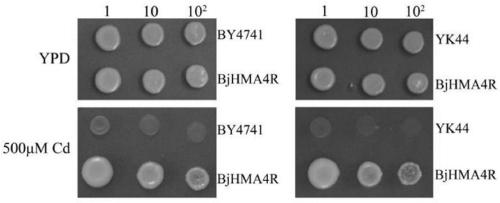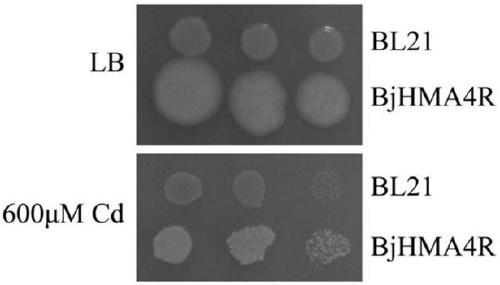A heavy metal cadmium-specific binding protein gene BjHMA4R and encoding protein and application thereof
A protein-binding and heavy metal-binding technology, applied in the fields of molecular biology and genetic engineering technology research, can solve problems such as limiting the application of microbial methods, improve cadmium tolerance and enrichment ability, strong salt and alkali resistance, and broad market application foreground effect
- Summary
- Abstract
- Description
- Claims
- Application Information
AI Technical Summary
Problems solved by technology
Method used
Image
Examples
Embodiment 1
[0029] Example 1: BjHMA4R gene fragment cloning and sequence analysis
[0030] The HMA4 gene BjHMA4 (NCBI accession number JQ673430) obtained in the early stage was used as a template to amplify the target gene BjHMA4R, and the sequence of the upstream primer used was BjHMA4R-F-KpnI: 5`-GGGGTACCATGAAGAAACCAAGTAGT-3`, the downstream The primer sequence of SEQ ID NO: 4 is BjHMA4R-R-XhoI:5'-CCGCTCGAGTCAAAGCAGTCCCCACATG-3'. The target gene BjHMA4R was amplified using Pyrobest DNA Polymerase PCR Enzyme (TakaraBio); PCR reaction conditions: 95°C for 1min; 94°C for 30s, 55°C for 30s, 72°C for 40s, 30 cycles; 72°C for 5min; the reaction system (10 μL) was 1μL cDNA, 1μL 10×Advantage 2 PCR Buffer, 0.5μL 50×dNTP Mix (10mM each), 0.2μL Forward Primer (10μM), 0.2μL Reverse Primer (10μM), 0.2μL PyrobestDNA Polymerase Mix, 6.9μL PCR-Grade water; after PCR, take 5 μL for agarose gel electrophoresis to detect the specificity and size of the amplified product.
[0031] The PCR product obtaine...
Embodiment 2
[0032] Example 2: Yeast overexpression vector construction, transformation and screening of transformants
[0033] The Escherichia coli plasmid pMD-18T-BjHMA4R inserted into BjHMA4R and the plasmid of yeast expression vector pYES2 were extracted using the SanPrep column plasmid DNA mini-extraction kit (Shanghai Sangong), and 1 μL was used for agarose gel electrophoresis to detect the extracted Integrity and concentration of the plasmid; use restriction endonucleases KpnI (TaKaRa) and XhoI (TaKaRa) to double-enzyme digest the plasmids pMD-18T-BjHMA4R and pYES2 respectively (100μL system), the reaction system and operation process are as follows: 20 μL pMD-18T-BjHMA4R and pYES2 plasmids, add 10 μL 10×K buffer, 4 μL KpnI, 6 μL XhoI, 60 μL ddH in sequence 2 O, after mixing, centrifuge for a short time, and place it at 37°C for overnight reaction; spot all the digested products on agarose gel for electrophoresis, and then perform gel recovery on the BjHMA4R fragment and the large f...
Embodiment 3
[0038] Example 3: Escherichia coli overexpression vector construction, transformation and screening of transformants
[0039] Use the recovered BjHMA4R fragment and pEASY-Blunt E1 expression vector (full-style gold biology) to connect when constructing the yeast expression vector above. After mixing, centrifuge for a short time, and then react overnight in a water bath at 16°C. Then, the ligation product was transformed into Escherichia coli DH5α by heat shock transformation method, and positive clones were screened with solid medium containing 50 mg / L kanamycin (Km). Select a single colony and shake the bacteria, and use the bacterial liquid as a template to perform PCR with the specific primers for amplifying BjHMA4R, and select the clone that successfully connects BjHMA4R and pYES2. If the detected strain is positive, add glycerol and store at -80°C for future use.
[0040] The pEASY-Blunt E1-BjHMA4R plasmid in the above Escherichia coli was extracted and purified, and the...
PUM
| Property | Measurement | Unit |
|---|---|---|
| molecular weight | aaaaa | aaaaa |
Abstract
Description
Claims
Application Information
 Login to View More
Login to View More - R&D
- Intellectual Property
- Life Sciences
- Materials
- Tech Scout
- Unparalleled Data Quality
- Higher Quality Content
- 60% Fewer Hallucinations
Browse by: Latest US Patents, China's latest patents, Technical Efficacy Thesaurus, Application Domain, Technology Topic, Popular Technical Reports.
© 2025 PatSnap. All rights reserved.Legal|Privacy policy|Modern Slavery Act Transparency Statement|Sitemap|About US| Contact US: help@patsnap.com



